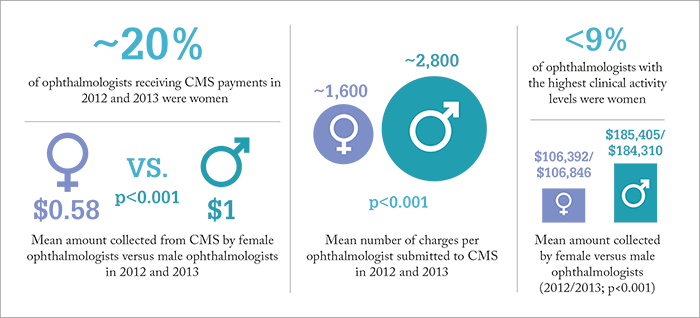
January 21, 2017 marked two key events in history – President Trump’s first full day in office and the Women’s March, which saw millions across the globe raising awareness of equality issues. The field of ophthalmology is not immune. Just two days prior, a collaboration of ophthalmologists and researchers published their gender-comparing study online on JAMA Ophthalmology (1).
The group wanted to know “How do the earnings and clinical activity of men and women compare?” To answer this, they used the publicly available Centers for Medicare and Medicaid Services (CMS) database to perform a retrospective review of the payments made to ophthalmologists (reflected in reimbursements from CMS) between January 1, 2012 and December 31, 2013. What did they find? We summarize the key findings (Figure 1):
- For every dollar earned by a male ophthalmologist through the CMS in 2012 and 2013, female ophthalmologists collected an average of 58 cents (p<0.001).
- Women submitted an average of 1120 and 1200 fewer charges than men in 2012 and 2013, respectively (both p<0.001).
- Mean collections in 2012 and 2013 by female ophthalmologists were $78,473 and $77,464 less than mean collections by male ophthalmologists, respectively (p<0.001).
- The mean payment per charge for both men and women was $66 in 2012 and $64 in 2013.
- Remuneration was lower for women, even when men and women with similar levels of clinical activity were compared.
Although the results reveal that there were disparities between men and women in terms of CMS payments, the study was not designed to answer why. Conceding that further research might “illuminate the reasons for clinical activity and financial differences,” the study authors conclude: “there is face validity to the position that women have fewer opportunities to pursue the same economic prospects as men. This finding warrants formal attention.” But what of pay gaps? Ruth Williams of Wheaton Eye Clinic, Illinois, who authored a corresponding commentary article(2), noted that: “There is debate about whether lower pay for women is related to personal choices or to systemic inequities. It’s both. [...] Women often have a different cadence to career. At the same time, institutional barriers still exist for women, and we are increasingly aware of them and increasingly free to point them out.”
References
- AK Reddy et al., “Differences in clinical activity and Medicare payments for female vs. male ophthalmologists”, JAMA Ophthalmol, (2017). [Epub ahead of print]. PMID: 28114631. RD Williams. “Medicare payments and physician sex in ophthalmology”, JAMA Ophthalmol, (2017). [Epub ahead of print]. PMID: 28114640.
